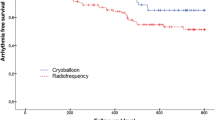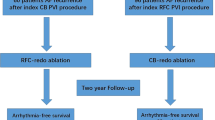Abstract
Purpose
Catheter ablation of atrial fibrillation (CAAF) using the cryoballoon has emerged as an alternate strategy to point-by-point radiofrequency. However, there is little comparative data on long-term durability of pulmonary vein (PV) isolation comparing these two modalities.
Methods
In this multicenter, retrospective analysis, the incidences/patterns of late PV reconnection following an index CAAF using the second-generation cryoballoon versus open-irrigated, non-force-sensing radiofrequency were examined.
Results
Of the 2002 patients who underwent a first-time CAAF, 186/1126 patients (16.5 %) ablated using cryoballoon and 174/876 patients (19.9 %) with non-contact force-guided radiofrequency required a repeat procedure at 11 ± 5 months. During follow-up, the incidence of atrial flutters/tachycardias was lower (19.9 vs. 32.8 %; p = 0.005) and fewer patients exhibited PV reconnection (47.3 vs. 60.9 %; p = 0.007) with cryoballoon versus radiofrequency. Additionally, fewer PVs had reconnected with cryoballoon versus radiofrequency (18.8 vs. 34.6 %; p < 0.001). With cryoballoon, the right inferior (p < 0.001) and left common (p = 0.039) PVs were more likely to exhibit late reconnection, versus the left superior PV with radiofrequency (p = 0.012). However, when comparing the two strategies, the left common PV was more likely to exhibit reconnection with cryoballoon, whereas all other PVs with the exception of the right inferior PV demonstrated a lower reconnection rate with cryoballoon versus radiofrequency. Lastly, in a logistic regression multivariate analysis, cryoballoon ablation and PV ablation time emerged as significant predictors of durable PV isolation at repeat procedure.
Conclusions
In this large multicenter, retrospective analysis, CAAF using the second-generation cryoballoon was associated with improved durability of PV isolation compared to open-irrigated, non-force-sensing radiofrequency.

Similar content being viewed by others
References
Packer DL, Kowal RC, Wheelan KR, Irwin JM, Champagne J, Guerra PG, et al. Cryoballoon ablation of pulmonary veins for paroxysmal atrial fibrillation: first results of the North American Arctic Front (STOP AF) pivotal trial. J Am Coll Cardiol. 2013;61(16):1713–23.
Fürnkranz A, Chun KR, Nuyens D, Metzner A, Köster I, Schmidt B, et al. Characterization of conduction recovery after pulmonary vein isolation using the “single big cryoballoon” technique. Heart Rhythm. 2010;7(2):184–90.
Fürnkranz A, Bordignon S, Dugo D, Perotta L, Gunawardene M, Schulte-Hahn B, et al. Improved 1-year clinical success rate of pulmonary vein isolation with the second-generation cryoballoon in patients with paroxysmal atrial fibrillation. J Cardiovasc Electrophysiol. 2014;25(8):840–4.
Aryana A, Morkoch S, Bailey S, Lim HW, Sara R, d’Avila A. Acute procedural and cryoballoon characteristics from cryoablation of atrial fibrillation using the first- and second-generation cryoballoon: a retrospective comparative study with follow-up outcomes. J Interv Card Electrophysiol. 2014;41(2):177–86.
Metzner A, Reissmann B, Rausch P, Mathew S, Wohlmuth P, Tilz R, et al. One-year clinical outcome after pulmonary vein isolation using the second-generation 28-mm cryoballoon. Circ Arrhythm Electrophysiol. 2014;7(2):288–92.
Di Giovanni G, Wauters K, Chierchia GB, Sieira J, Levinstein M, Conte G, et al. One-year follow-up after single procedure cryoballoon ablation: a comparison between the first and second generation balloon. J Cardiovasc Electrophysiol. 2014;25(8):834–9.
Reddy VY, Sediva L, Petru J, Skoda J, Chovanec M, Chitovova Z, et al. Durability of pulmonary vein isolation with cryoballoon ablation: Results from the Sustained PV Isolation with Arctic Front Advance (SUPIR) Study. J Cardiovasc Electrophysiol. 2015;26(5):493–500.
Anter E, Contreras-Valdes FM, Shvilkin A, Tschabrunn CM, Josephson ME. Acute pulmonary vein reconnection is a predictor of atrial fibrillation recurrence following pulmonary vein isolation. J Interv Card Electrophysiol. 2014;39(3):225–32.
Lin D, Santangeli P, Zado ES, Bala R, Hutchinson MD, Riley MP, et al. Electrophysiologic findings and long-term outcomes in patients undergoing third or more catheter ablation procedures for atrial fibrillation. J Cardiovasc Electrophysiol. 2015;26(4):371–7.
Tofield A. GAP-AF study helps to define optimal approach for atrial fibrillation ablation. Eur Heart J. 2014;35(18):1163–4.
Willems S, Steven D, Servatius H, Hoffmann BA, Drewitz I, Müllerleile K, et al. Persistence of pulmonary vein isolation after robotic remote-navigated ablation for atrial fibrillation and its relation to clinical outcome. J Cardiovasc Electrophysiol. 2010;21(10):1079–84.
Chinitz JS, Kulina RA, Gangireddy SR, Miller MA, Koruth JS, Dukkipati SR, et al. Objective quality assessment of atrial fibrillation ablation: a novel scoring system. Heart Rhythm. 2013;10(7):1074–9.
Neuzil P, Reddy VY, Kautzner J, Petru J, Wichterle D, Shah D, et al. Electrical reconnection after pulmonary vein isolation is contingent on contact force during initial treatment: results from the EFFICAS I study. Circ Arrhythm Electrophysiol. 2013;6(2):327–33.
Bordignon S, Chun KR, Gunawardene M, Fuernkranz A, Urban V, Schulte-Hahn B, et al. Comparison of balloon catheter ablation technologies for pulmonary vein isolation: the laser versus cryo study. J Cardiovasc Electrophysiol. 2013;24(9):987–94.
Aryana A, Singh SM, Kowalski M, Pujara DK, Cohen AI, Singh SK, et al. Acute and long-term outcomes of catheter ablation of atrial fibrillation using the second-generation cryoballoon versus open-irrigated radiofrequency: a multicenter experience. J Cardiovasc Electrophysiol. 2015;26(8):832–9.
Sauer WH, McKernan ML, Lin D, Gerstenfeld EP, Callans DJ, Marchlinski FE. Clinical predictors and outcomes associated with acute return of pulmonary vein conduction during pulmonary vein isolation for treatment of atrial fibrillation. Heart Rhythm. 2006;3(9):1024–8.
Kubala M, Hermida JS, Nadji G, Quenum S, Traulle S, Jarry G. Normal pulmonary veins anatomy is associated with better AF-free survival after cryoablation as compared to atypical anatomy with common left pulmonary vein. Pacing Clin Electrophysiol. 2011;34(7):837–43.
Chun KR, Schmidt B, Metzner A, Tilz R, Zerm T, Köster I, et al. The ‘single big cryoballoon’ technique for acute pulmonary vein isolation in patients with paroxysmal atrial fibrillation: a prospective observational single centre study. Eur Heart J. 2009;30(6):699–709.
Heeger CH, Wissner E, Mathew S, Deiss S, Lemes C, Rillig A, et al. Once isolated, always isolated? Incidence and characteristics of pulmonary vein reconduction after second-generation cryoballoon-based pulmonary vein isolation. Circ Arrhythm Electrophysiol. 2015;8(5):1088–94.
Juliá J, Chierchia GB, de Asmundis C, Mugnai G, Sieira J, Ciconte G, et al. Regular atrial tachycardias following pulmonary vein isolation for paroxysmal atrial fibrillation: a retrospective comparison between the cryoballoon and conventional focal tip radiofrequency techniques. J Interv Card Electrophysiol. 2015;42(2):161–9.
Andrade JG, Dubuc M, Guerra PG, Macle L, Mondésert B, Rivard L, et al. The biophysics and biomechanics of cryoballoon ablation. Pacing Clin Electrophysiol. 2012;35(9):1162–8.
Jiang H, Lu Z, Lei H, Zhao D, Yang B, Huang C. Predictors of early recurrence and delayed cure after segmental pulmonary vein isolation for paroxysmal atrial fibrillation without structural heart disease. J Interv Card Electrophysiol. 2006;15(3):157–63.
Sotomi Y, Inoue K, Ito N, Kimura R, Toyoshima Y, Masuda M, et al. Incidence and risk factors for very late recurrence of atrial fibrillation after radiofrequency catheter ablation. Europace. 2013;15(11):1581–6.
Squara F, Zhao A, Marijon E, Latcu DG, Providencia R, Di Giovanni G, et al. Comparison between radiofrequency with contact force-sensing and second-generation cryoballoon for paroxysmal atrial fibrillation catheter ablation: a multicentre European evaluation. Europace. 2015;17(5):718–24.
Ciconte G, Velagić V, Mugnai G, Saitoh Y, Irfan G, Hunuk B, et al. Electrophysiological findings following pulmonary vein isolation using radiofrequency catheter guided by contact-force and second-generation cryoballoon: lessons from repeat ablation procedures. Europace. 2015. [Epub ahead of print].
Author information
Authors and Affiliations
Corresponding author
Ethics declarations
Conflicts of interest
Drs. Aryana, Brugada, Chierchia, de Asmundis, Kowalski, and O’Neill have received consulting fees and speaker honoraria and Drs. Aryana and O’Neill have received a research grant from Medtronic, Inc. Additionally, Drs. Aryana, Cohen, Fuenzalida, and d’Avila have received consulting fees and speaker honoraria, and Drs. Aryana and O’Neill have received research grants from Biosense Webster, Inc.
Rights and permissions
About this article
Cite this article
Aryana, A., Singh, S.M., Mugnai, G. et al. Pulmonary vein reconnection following catheter ablation of atrial fibrillation using the second-generation cryoballoon versus open-irrigated radiofrequency: results of a multicenter analysis. J Interv Card Electrophysiol 47, 341–348 (2016). https://doi.org/10.1007/s10840-016-0172-z
Received:
Accepted:
Published:
Issue Date:
DOI: https://doi.org/10.1007/s10840-016-0172-z




